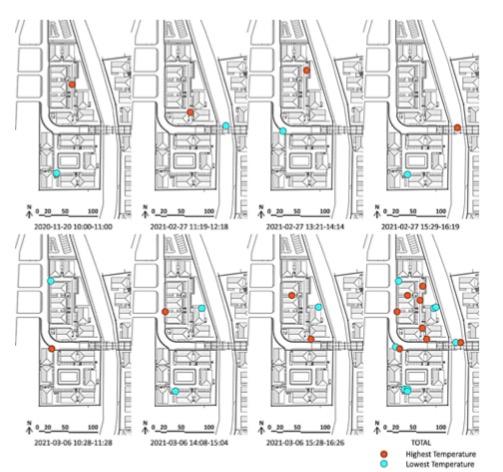Improving thermal comfort in the urban landscape of housing communities in tropical climate: A case study of Bang Chalong Community, Thailand
DOI:
https://doi.org/10.56261/built.v20.246808Keywords:
low-income housing, urban landscape, thermal comfort, tropical climateAbstract
In developing countries, low-income housings seem to sacrifice quality over quantity. For a tropical country such as Thailand, where the temperature remains consistently high throughout the year, thermal comfort impacts living quality, especially in urban areas. Bang Chalong Community is a cluster of densely arranged mid-rise apartments in Samut Prakan, the peri-urban area of Bangkok, chosen by the NHA (National Housing Authority) to improve its living quality as a pilot project. While current literature investigates and explores solutions to mitigate thermal comfort in buildings, few studies focus on outdoor areas adjacent to buildings. This research aims to assess the outdoor hot-spot of the community, proposes appropriate attributes and design approaches to improve urban landscape elements leading to comfortable conditions, and recommends landscape design strategies for similar future development.
The thermal condition was conducted using the Wet Bulb Globe Temperature (WBGT) data logger on 25 locations. The ambient temperature (TG) was used as the indicator for thermal comfort. It is found that critical attributes affecting the thermal condition are 1) the type of surfaces – hardscape or soft scape, and 2) the amount of surface and time exposed to solar energy – shade or sunlight. The thermal comfort improvement, including potential uses by landscape design, was proposed under four strategies; shading, added green, orientation & ventilation, and functional refinement. They are recommended to create suitable thermal comfort by landscape design for future development of a similar type
Downloads
References
https://doi.org/10.1016/S0378-7788(02)00085-3
Akbari, H., Menon, S., & Rosenfeld, A. (2009). Global cooling: Increasing world-wide urban albedos to offset CO 2. Climatic Change, 94(3–4), 275–286. https://doi.org/10.1007/s10584-008-9515-9
Akbari, H., Pomerantz, M., & Taha, H. (2001). Cool surfaces and shade trees to reduce energy use and improve air quality in urban areas. Solar Energy, 70(3), 295–310. https://doi.org/10.1016/S0038-092X(00)00089-X
American Society of Heating, Refrigerating and Air-Conditioning Engineers, I. (1997). ASHRAE Handbook 1997: Fundamentals. SI Edition.
Arifwidodo, S. D., & Tanaka, T. (2015). The Characteristics of Urban Heat Island in Bangkok, Thailand. Procedia - Social and Behavioral Sciences, 195. https://doi.org/10.1016/j.sbspro.2015.06.484
Baqutaya, S., Ariffin, A. S., & Raji, F. (2016). Affordable Housing Policy: Issues and Challenges among Middle-Income Groups. International Journal of Social Science and Humanity, 6(6). https://doi.org/10.7763/ijssh.2016.v6.686
Bhikhoo, N., Hashemi, A., & Cruickshank, H. (2017). Improving thermal comfort of low-income housing in Thailand through passive design strategies. Sustainability (Switzerland), 9(8). https://doi.org/10.3390/su9081440
Chohan, A. H., Che-Ani, A. I., Bhai Khan, S., Awad, J., Jawaid, A., & Mohd Tawil, N. (2015). A Model of Housing Quality Determinants (HQD) for Affordable Housing. Journal of Construction in Developing Countries, 20(1).
Eliasson, I. (2000). The use of climate knowledge in urban planning. Landscape and Urban Planning, 48(1–2). https://doi.org/10.1016/S0169-2046(00)00034-7
Fuller, T. D., Edwards, J. N., Sermsri, S., & Vorakitphokatorn, S. (1993). Housing, stress, and physical well-being: Evidence from Thailand. Social Science and Medicine, 36(11). https://doi.org/10.1016/0277-9536(93)90384-G
Gunawardena, K. R., Wells, M. J., & Kershaw, T. (2017). Utilising green and bluespace to mitigate urban heat island intensity. Science of the Total Environment, 584–585, 1040–1055. https://doi.org/10.1016/j.scitotenv.2017.01.158
Iamtrakul, P., Nusook, T., & Ubolchay, P. (2013). ผลกระทบของปัญหาสภาวะเกาะความร้อนเมืองต่อการใช้ชีวิตประจำวันของคนในกรุงเทพมหานครและปริมณฑล Impact of Urban Heat Island on Daily Life of People in Bangkok Metropolitan Region ( BMR ). 53–72.
Jareemit, D., & Srivanit, M. (2022). A Comparative Study of Cooling Performance and Thermal Comfort under Street Market Shades and Tree Canopies in Tropical Savanna Climate. Sustainability (Switzerland), 14(8). https://doi.org/10.3390/su14084653
Khamchiangta, D., & Dhakal, S. (2021). Future urban expansion and local climate zone changes in relation to land surface temperature: Case of Bangkok Metropolitan Administration, Thailand. Urban Climate, 37. https://doi.org/10.1016/j.uclim.2021.100835
Koerniawan, M. D., & Gao, W. (2016). Investigation and Evaluation of Thermal Comfort and Walking Comfort in Hot-Humid Climate Case Study : The Open Spaces of Mega Kuningan-Superblock in Jakarta Investigation and Evaluation of Thermal Comfort and Walking Comfort in Hot-Humid Climate Case Stud. International Journal of Building, Urban, Interior and Landscape Technology (BUILT), 6(July), 53–72.
Landsberg, H. E. (1981). The Urban Climate. Acedemic press.
OLGYAY, V. (1962). BIOCLIMATIC EVALUATION METHOD FOR ARCHITECTURAL APPLICATION. In Biometeorology. https://doi.org/10.1016/b978-0-08-009683-4.50034-6
Rinchumphu, D., Phichetkunbodee, N., Pomsurin, N., Sundaranaga, C., Tepweerakun, S., & Chaichana, C. (2021). Outdoor Thermal Comfort Improvement of Campus Public Space. Advances in Technology Innovation, 6(2). https://doi.org/10.46604/aiti.2021.6453
Sadrian, Z., Yazdanfar, S. A., Hosseini, S. B., & Norouzian-Maleki, S. (2015). An evaluation of factors affecting the quality of life in low-income housing environments. International Journal of Architectural Engineering & Urban Planning, 25(2).
Sharipah, N. (2011). Quality Affordable Housing: A Theoretical Framework for Planning and Design of Quality Housing. Journal of Techno-Social, 2(1).
Srivanit, M., & Auttarat, S. (2015). The Summer Thermal Environment and Human Comfort of Shaded Outdoor and Semi-Outdoor Spaces to Living in the Urban Area of Chiang Mai City. Journal of Architecture/Planning Research and Studies.
Thammapornpilas, J. (2015). Urban Spatial Development to Mitigate Urban Heat Island Effect in the Inner Area of Bangkok. Nakhara : Journal of Environmental Design and Planning, Vol. 11, 29–40. https://doi.org/https://ph01.tci-thaijo.org/index.php/nakhara/article/view/104849
US EPA. (2013). Reducing Urban Heat Islands: Compendium of Strategies | Heat Island Effect | US EPA. Us Epa. https://www.epa.gov/heatislands/heat-island-compendium

Downloads
Published
How to Cite
Issue
Section
License
Copyright (c) 2022 International Journal of Building, Urban, Interior and Landscape Technology (BUILT)

This work is licensed under a Creative Commons Attribution-NonCommercial-NoDerivatives 4.0 International License.











